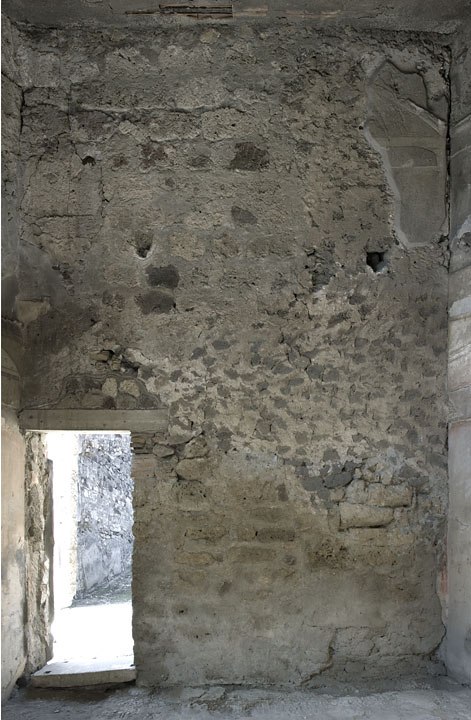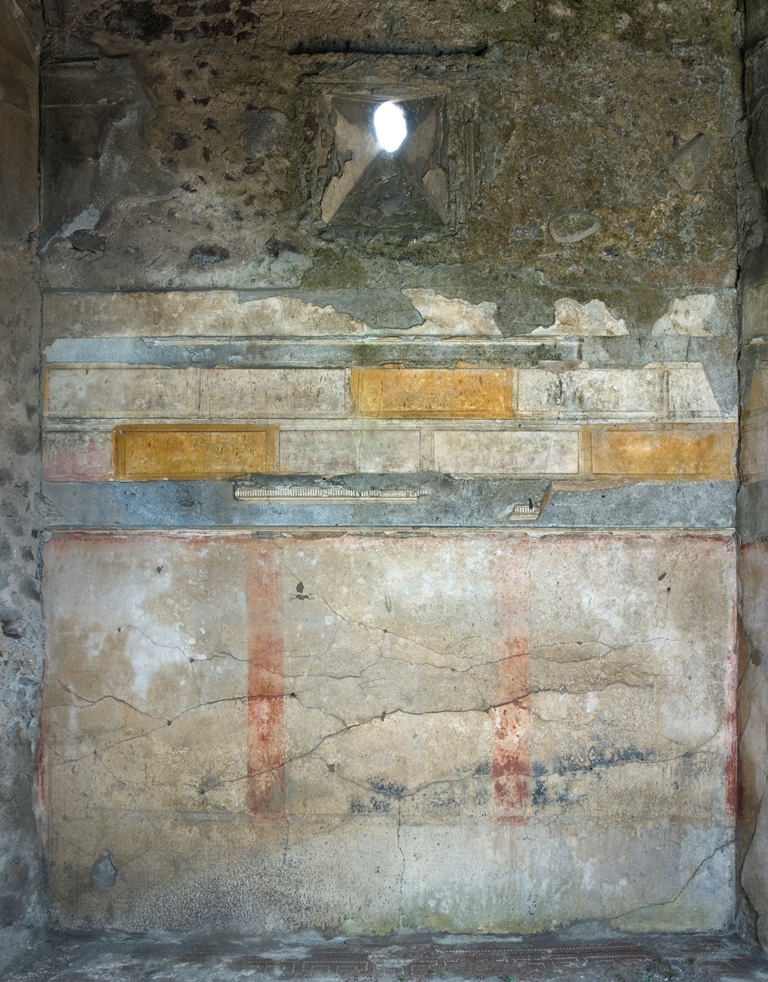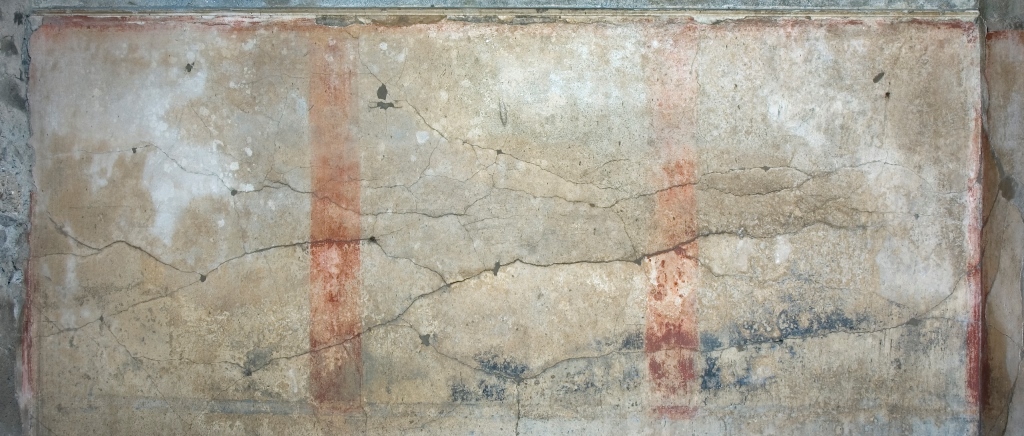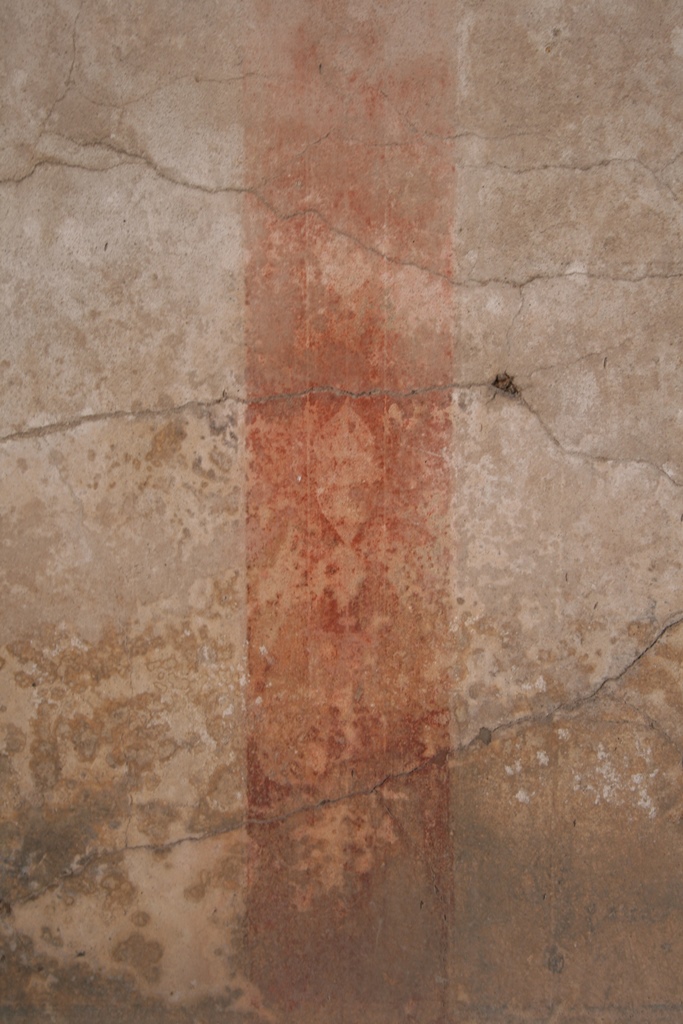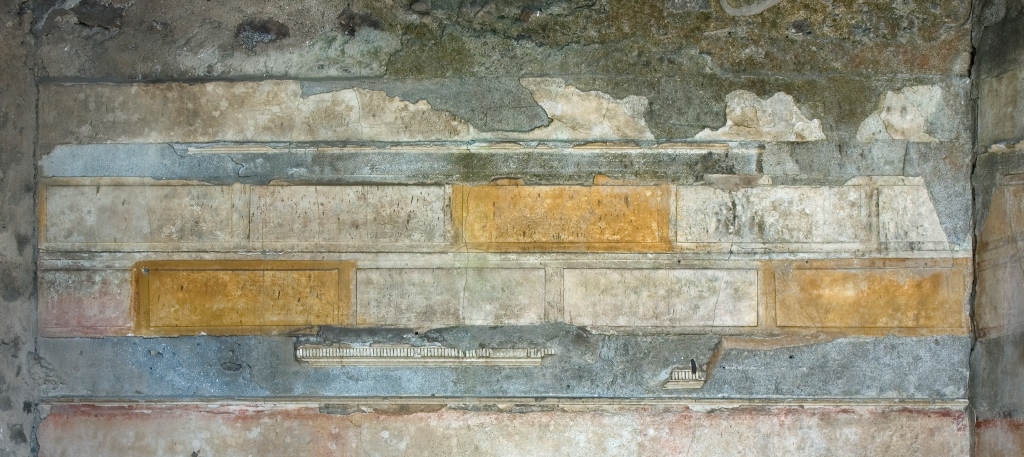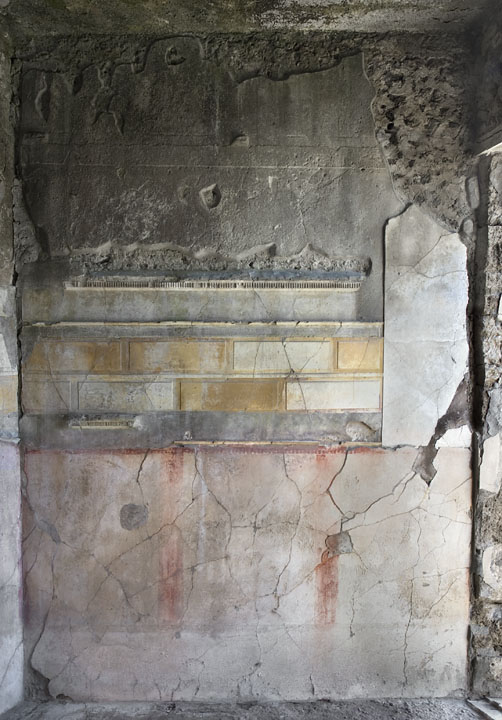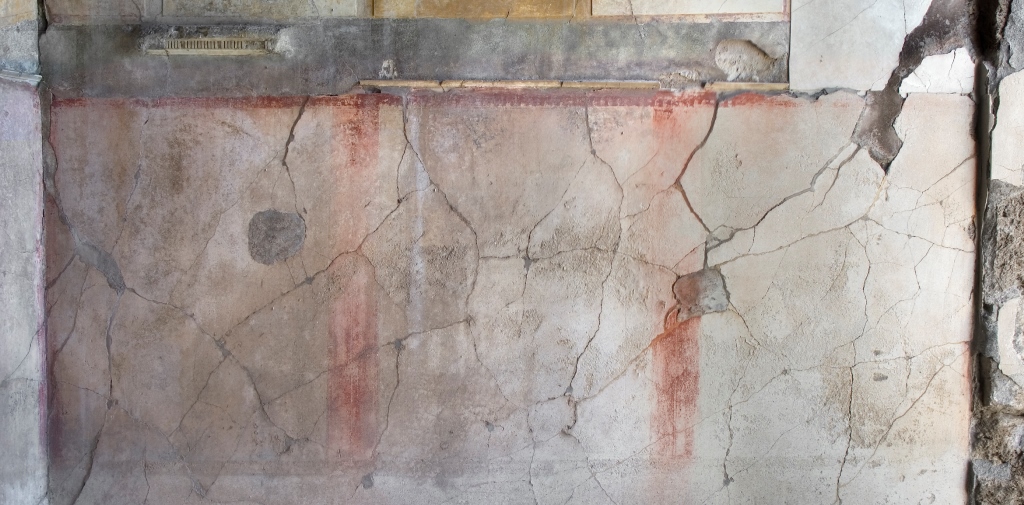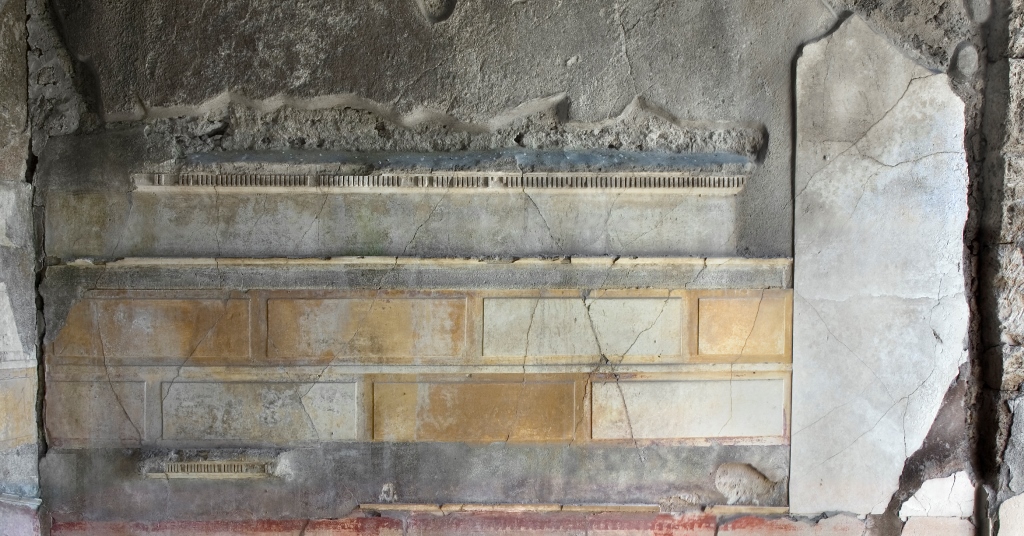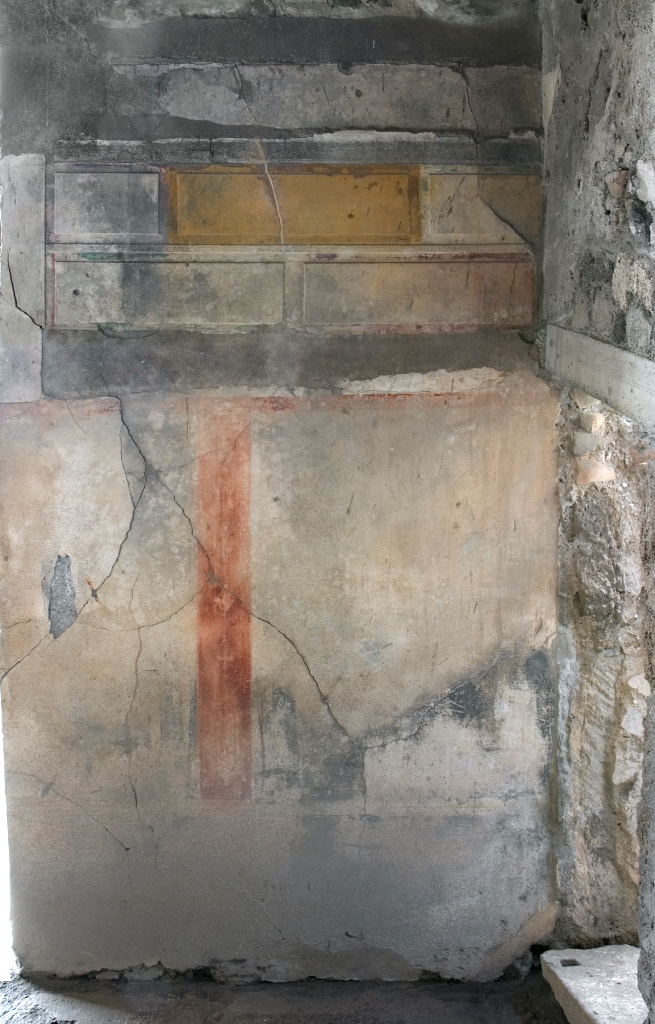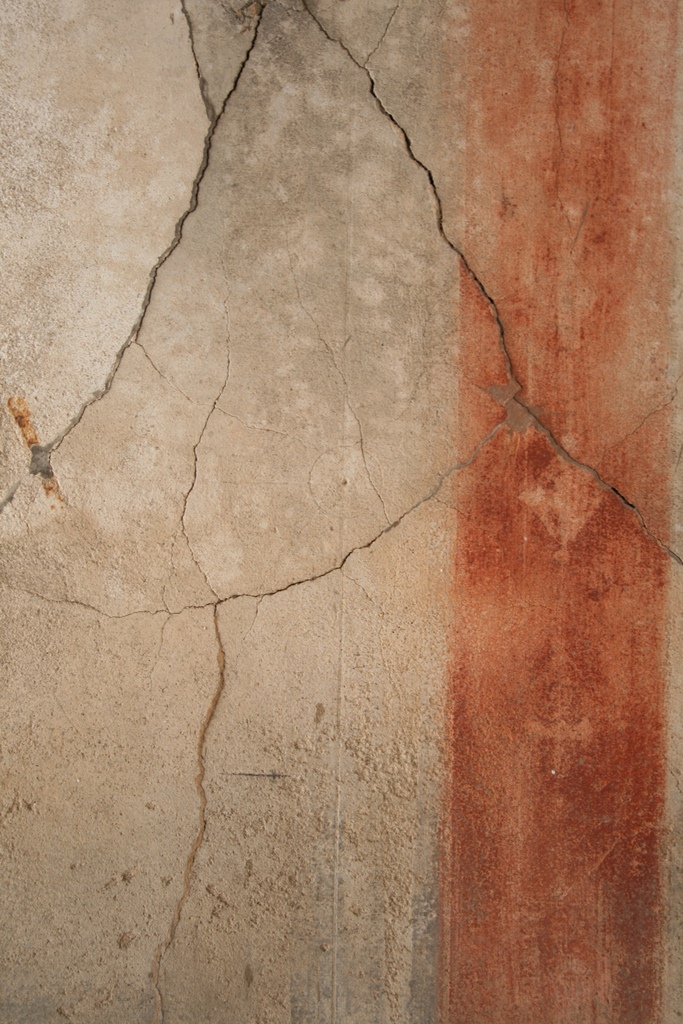Wall decoration (extant)
Description
Thomas Staub
Remains of the decorations in the socle and middle zones, belonging to the third style, and in the upper zone belonging to the First Style, are preserved on the south, west, and east walls, whereas the north wall only shows some remains of the probable preparation work for a stuccoed decoration of the uppermost part of the wall.
N wall
On the north wall, hardly any traces of the decorations are preserved. In the lower parts of the wall, only a max. 0.10 m wide stripe in the nort eastern corner, between 0.50 and 1.10 m height, shows the same kind of structuring and colouring as in its south eastern counterpart. In the uppermost part of the wall, again some remains of under plaster with preparatory stucco work can be observed between 3.60 and 4.60 m height, max. 0.60 m wide. In 3.95 m height, a 0.15 m high vertical stripe protrudes for about 0.007 m, followed by a 0.08 m h recessed part. Above this, remains of the frame (approx. height: 0.08 m) of a reliefed arch can be observed in the under plaster, its springing line in 4.20 m height, and the max. preserved height at 0.65 m from the north eastern corner at 4.50 m. Set into relation with the total width of the wall (3.25 m), its crown in the middle of the wall would thus have been 4.95 m in height.
E wall
On this wall the composition of the decorations can be made out in the socle, midle and lower part of the upper zone, where as most of the ornamental details are lost. The two lower zones are showing a mature but restrained Third Style, where as the upper zone has preserved decorations belonging to the First Style. Both socle and middle zone are tripartite, with black as dominating colour, the deviders, which in the middle zone are decorated with thin columns and candelabras are red. The middle and upper zone are separated by a dental frieze, above two rows of imitaded blocks of marble, made in stucco, from the First Style can be observed. Some further remains of preparatory plaster for another stuccoed frieze can be obseved high up near the northeastern corner.
S wall
The decorations of the south wall are quite well preserved, so that the composition of the socle, middle and lower part of the upper zone can be recognized. Once more the ornamental detail however are lost. The two lower zones are showing a mature but restrained Third Style, where as the upper zone has preserved decorations belonging to the First Style. Both socle and middle zone are tripartite, with black as dominating colour, the deviders, which in the middle zone are decorated with candelabras are red. The middle and upper zone are separated by a dental frieze. Above this two rows of imitaded blocks of marble, made in stucco, from the First Style can be observed, followed higher up by a second, slightly larger dental frieze. In the uppermost part only the under plaster is preserved with some preparatory stucco layer forming a horizontal stripe. The western most part of the upper zone shows a smoth field without any stuccoed decorations, probably because the door from the opening towards the atrium, which opened towards that wall could have damaged any protruding elements.
W wall
On this wall the composition of the decorations can be made out in the socle, midle and lower part of the upper zone, where as most of the ornamental details are lost. The two lower zones are showing a mature but restrained Third Style, where as the upper zone has preserved decorations belonging to the First Style. In composition and dimensions this wall follows the same scheme as its eastern counterpart, with the difference, that the position of the doorway towards the atrium takes up the southern part of the wall, so that only one and a half of the three wall fields were made. The devider between this two fields, which in the middle zone is decorated with a thin column is red. The middle and upper zone are separated by a dental frieze, above two rows of imitaded blocks of marble, made in stucco, from the First Style can be observed. Only under plaster is preserved in the uppermost parts of the wall.
East wall
The east wall is covered with plaster up to 3.10 m height, at the northern corner also in a 0.40 m wide stripe between 3.25 and 4.20 m. In 1.95 m height, a joint separates the plaster of the socle and middle zone decorations from the ones in the upper zone. The plaster of the Third Style decorations reaches over the First Style plaster.
The black socle zone is 0.62 m high and is separated from the middle zone by a 0.04 m high light horizontal stripe with a thin (0.005 m) line running in its mid. At 0.90 m and 1.25 m distance from each corner, thin vertical red lines are structuring the socle zone. They are 0.008 m wide and two 0.002 m wide white lines frame each.
The middle zone is 1.25 m high and is divided into three equally wide (0.95 m) fields. Along the corners, 0.04 m wide red lesenes frame this zone. The 0.18 m wide dividers between the three fields are painted red as well, and were adorned with painted, today hardly visible, thin columns. These columns are decorated with ornamental pattern, s.c. "Säulenmanschetten", round, pelta - formed or diamond-shaped, of which only faint shadows are preserved. In the wall fields, remains of colour indicate that they were painted black. Thin vertical scratch lines are visible at 0.09 m distance from the dividing fields.
A cornice (0.027 m high) with a cyma reversa moulding marks the beginning of the upper zone in first style. Above this, in a 0.10 m high area, only the under plaster is preserved. Above this follows a dentil pattern frieze, height 0.105 m, max. 0.06 m deep, tooth 0.01 m wide and 0.028 m high (on the southern part reattached to the wall in modern times at a wrong height). Two rows of imitated laying marble blocks adorn the next, 0.55 m high, zone of the wall. The slightly protruding parts of the blocks are 0.64 x 0.20 m large, each with a 0.03 m wide frame, separated from each other by a thin line in the stucco. The blocks of the upper layer are shifted for half their width. The colours of the blocks of the lower layer are (from north to south): half block red, one block yellow, the next one with both red and yellow remains, one block red, and the last one yellow. A 0.03 m high stripe separates the two layers from each other. In the upper layer, the colours are as follows: one block yellow, one block red, one block yellow, one block without colour traces and, finally, a half block with some remains of green. Above this zone with the imitated marble blocks, a 0.10 m high stripe preserves only the under plaster, followed by a slightly larger cornice with a cyma reversa moulding (height: approx. 0.032 m). The uppermost part of the preserved decorations of this wall is constituted by a 0.22 m high stripe of white unadorned stucco, above this only the under plaster is preserved on some parts of the wall, except for the fine plaster, partly preserved in the window frames. At the north east corner, remains of a protruding stripe, followed by remains of a cornice, are visible in 3.90 - 4.20 m height.
South wall
The socle and middle zones of the south wall show the same structures as on the east wall, except that the decoration in the red dividing fields are even thinner on this wall (approx. 0.01 m). Probably they have represented candelabras; the eastern one seems to have a crown-like top (approx. 0.05 m under the upper end of this field). In 0.95 m height, they both show round scratch lines (ï?´† 0.045 m), with a small hole after the tip of the compass.
Also, the upper zone is nearly identical in its structure with the one on the east wall. Only the westernmost (width: 0.69 m) part differs since it is without any decorations or structuring, only showing a smooth white surface, probably because the door to atrium4 opened up into the room at this corner and could have damaged protruding parts of a stuccoed decoration. The colours of the imitated marble blocks are as follows (from east to west): half block red, one block yellow with fragments of green on its frame, one block yellow, one block red and in the upper layer: one block yellow, one block with yellow and red, one block without colour traces and one small block (width: 0.31 m, framed also at the outer, western side) yellow. The upper part of the upper zone is slightly better preserved on this wall than on the eastern one, showing a second dentil pattern frieze above the 0.22 m high unadorned band over the upper cornice. Like the upper cornice in comparison to the lower one, also the upper dentil frieze is slightly larger than the lower one (height: 0.125 m, tooth 0.012 m wide, 0.04 m high), so that this upper part simply seems to be an enlarged replica of the lower one. The friezes and cornices are worked in corners at the boundary towards the unadorned western area, as if continuing into the wall. The uppermost part of the wall shows again the same structure as seen at the north east corner, but here unstructured under plaster continues for a further 0.60 m height.
West wall
The decorations on the west wall are more or less following the same scheme with the same colours as on the other walls. However, because of the door towards atrium4 there is space for only one complete wall field, the northern one. Towards north, the plaster continues over the corner into the eastern doorframe towards ala9, without the usual corner lesene found on the other walls. The northern wall field is 0.99 m wide, the southern one, also without a lesene at its edge, 0.65 m with the black colour continuing into the oblique part of the doorframe. 0.095 m to the south of the north west corner, a vertical scratch line can be observed, as well as to the south and north of the red dividing section. In contrast to the other walls, horizontal lines were scratched into the plaster as well, starting from the vertical ones and leading into the two main wall fields. At the crossing point of the horizontal and vertical lines, holes after the tip of compasses are visible, surrounded by a 0.06 m wide circle. Small columns adorn the dividing fields as on the east wall, again with "Säulenmanschetten", maybe with a peltamotive at the bottom and a diamond form in the middle of the shaft.
On this wall, no remains of the two lower friezes are preserved, nor of the upper dentil pattern frieze. Only some remains of the upper cornice can be observed. Again, the area next to the door is unstructured and undecorated, showing a 0.15 m wide smooth white surface, continuing into the frame. The imitated marble blocks are slightly wider on this wall, each ca. 0.75 m wide, in the lower layer with two blocks, the southern one with traces of green and red colours, the northern one red. The upper layer consists of one smaller red block (0.34 m wide) at the south, followed by one yellow block, and in the north west corner one half block with traces of green colour. Above this follows again a 0.08 m high stripe covered only by under plaster, then the cornice with the cyma reversa moulding, and then the 0.20 m high white stripe. Above this, only some remains of under plaster are preserved.

